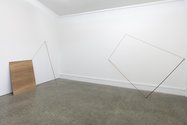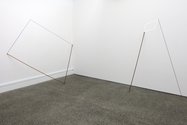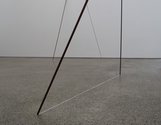John Hurrell – 8 March, 2017
The cycles of animated movement that usually take up a quarter of each perimeter, with intense viewing start to become unstable over time, so that the loops seem to chronologically distort and stretch. You start to doubt your own observations, dismantling your own carefully constructed perceptions about the programmed systemic movement.
In this second show of Kāryn Taylor at Sanderson, she continues to move away from the glowing ‘electrical’ lines of colour encased in translucent acrylic slabs she is more known for, though several of those are presented in an adjacent group show in the large gallery space. In the smaller room, she develops further her investigations into animated moving line, linking her practice with artists like Anthony McCall (projected moving line), Robert Mangold (linear quadrilaterals on canvas), Fred Sandback (taut coloured wool pulled across space) and Josef Albers (ambiguous perspective studies).
This work now has a wonderfully relaxed casualness that hides her fastidious precision, a studied (but super tight) nonchalance - and similar works will be shown in a G.A.A. Personal Structures show, a satellite Biennale exhibition soon to be held in Venice in May.
Time. Space. Existence. in Auckland has four works, with only three incorporating moving glowing lines, though one with a pale painted line on the floor could be mistaken for incorporating a projection. Taylor is an expert at controlling nuances of tone, manipulating it so it resonates according to adjacent background context.
With the projected shifting lines, angles enlarge or shrink, bending curved lines swell or shift from concave to convex, and single lines split to become double, turning then into compressed (then opening up) diamonds which become twisting rectangles. Planes (consisting of, say, plywood sheets) leaning against the wall provide edges that link up with (also leaning) lengths of rusty-coloured dowel, or thin straight grey plastic tubing that turns out to be at right-angles, or painted stationary gouache (or projected moving) lines on floor or walls.
To get the best out of each work you can’t just passively look at it, you need to bodily engage by thinking about perspective and parallax, noticing how your standing position as observer changes the alignment of each contemplated joined-up line. The cycles of animated movement that usually take up a quarter of each perimeter, with intense viewing start to become unstable over time, so that the loops seem to chronologically distort and stretch. You start to doubt your own observations, dismantling your own carefully constructed perceptions about the programmed systemic movement.
In an odd sense, the works take on their own personalities, confronting you as you try and confront them. As geometric configurations they seem to become living creatures that are strong willed and alive, trying to dominate you; restless entities that refuse to be predictable.
John Hurrell








 Two Rooms presents a program of residencies and projects
Two Rooms presents a program of residencies and projects Advertising in this column
Advertising in this column



This Discussion has 0 comments.
Comment
Participate
Register to Participate.
Sign in
Sign in to an existing account.